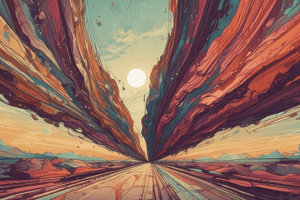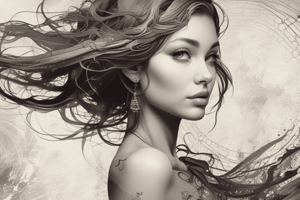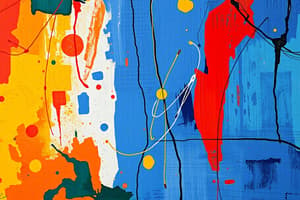Podcast
Questions and Answers
What is the primary way to appreciate texture in a work of art?
What is the primary way to appreciate texture in a work of art?
- By seeing it with our eyes
- By hearing it with our ears
- By touching it with our hands (correct)
- By smelling it with our nose
What is aerial perspective in art?
What is aerial perspective in art?
- The use of space to create a sense of distance
- The representation of an appearance of distance by means of converging lines
- The representation of relative distances of objects by gradations of tone and color (correct)
- The use of texture to create a sense of depth
What is positive space in a work of art?
What is positive space in a work of art?
- The negative space in a sculpture
- The background of a picture
- The main focus of a picture (correct)
- The empty space around a subject
What is the main difference between physical and visual texture?
What is the main difference between physical and visual texture?
What is the primary way to create a sense of distance in a work of art?
What is the primary way to create a sense of distance in a work of art?
What is the term for the perceived surface quality of a work of art?
What is the term for the perceived surface quality of a work of art?
What is the term for the distances or areas around, between or within components of a piece?
What is the term for the distances or areas around, between or within components of a piece?
What is the term for the representation of an appearance of distance by means of converging lines?
What is the term for the representation of an appearance of distance by means of converging lines?
What is an essential characteristic of a horizontal line?
What is an essential characteristic of a horizontal line?
What do diagonal lines suggest in art?
What do diagonal lines suggest in art?
Which type of line is used to create zigzag patterns?
Which type of line is used to create zigzag patterns?
What is a characteristic of curved lines in art?
What is a characteristic of curved lines in art?
What is the function of vertical lines in art?
What is the function of vertical lines in art?
Which element of art is used to create the basic framework of many forms?
Which element of art is used to create the basic framework of many forms?
What is the direction of a horizontal line?
What is the direction of a horizontal line?
Which type of line lacks softness and flexibility?
Which type of line lacks softness and flexibility?
Which of the following line types suggests grace, subtleness, direction, and instability?
Which of the following line types suggests grace, subtleness, direction, and instability?
What is the term for the brightness or darkness of a color?
What is the term for the brightness or darkness of a color?
What are the three primary colors?
What are the three primary colors?
Which type of line is often used to express action, excitement, and violence?
Which type of line is often used to express action, excitement, and violence?
What is the term for the lightness or darkness of a color?
What is the term for the lightness or darkness of a color?
Which colors are often associated with warmth and advancing in an artwork?
Which colors are often associated with warmth and advancing in an artwork?
What is the term for the actual color of an object, such as red or blue?
What is the term for the actual color of an object, such as red or blue?
What type of line is often used to convey a sense of restlessness and anxiety?
What type of line is often used to convey a sense of restlessness and anxiety?
Flashcards are hidden until you start studying
Study Notes
Texture
- Texture is the perceived surface quality of a work of art.
- It is an element of two-dimensional and three-dimensional designs.
- Texture is distinguished by its perceived visual and physical properties.
- Physical texture refers to the tactile quality of a work.
- Visual texture is the representation of texture in a work.
Perspective
- Perspective is the effect of distance on the appearance of objects.
- Perspective is used to create the illusion of depth on a flat surface.
- There are two kinds of perspective:
- Linear perspective: represents distance through converging lines.
- Aerial perspective: represents distance through gradations of tone and color.
Space
- Space refers to distances or areas around, between, or within components of a piece.
- Space can be positive or negative, open or closed, shallow or deep, and two-dimensional or three-dimensional.
- Positive space refers to the main focus of a picture.
- Negative space refers to the background.
Elements of Art
- The elements of art are the building blocks of all art.
- The elements of art are: line, color, texture, shape/form, space, and volume.
Line
- Line is an important element of art.
- Lines always have direction.
- Classification of lines:
- Horizontal lines: suggest repose and serenity.
- Vertical lines: suggest action, poise, balance, and force.
- Diagonal lines: suggest action, life, and movement.
- Zigzag lines: express action, excitement, and anxiety.
- Curved lines: suggest grace, subtleness, and flexibility.
Color
- Color is a property of light.
- Delight in color is a universal human characteristic.
- Color has three main characteristics:
- Hue: refers to the color's name (e.g., red, blue, green).
- Intensity: refers to the brightness or darkness of a color.
- Value: refers to the lightness or darkness of a color.
- Colors can have different temperatures:
- Warm colors: advance in an artwork (e.g., red, yellow, orange).
- Cool colors: recede in an artwork (e.g., blue, green, violet).
Studying That Suits You
Use AI to generate personalized quizzes and flashcards to suit your learning preferences.




